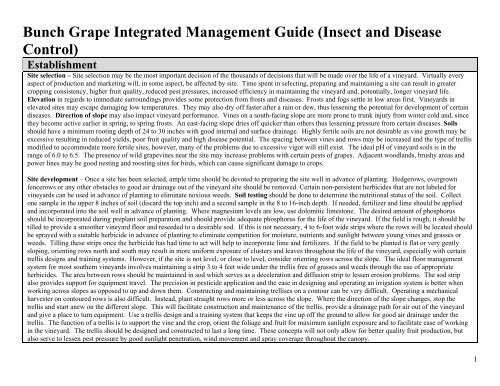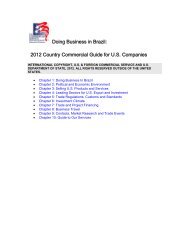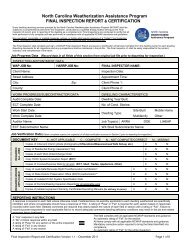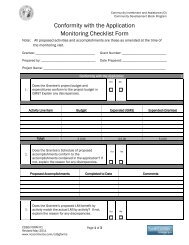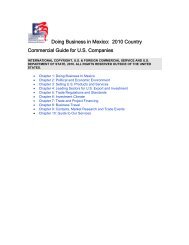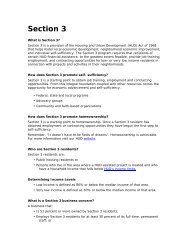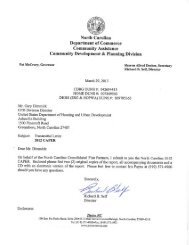Southeast Regional Bunch Grape Integrated Management Guide
Southeast Regional Bunch Grape Integrated Management Guide
Southeast Regional Bunch Grape Integrated Management Guide
Create successful ePaper yourself
Turn your PDF publications into a flip-book with our unique Google optimized e-Paper software.
<strong>Bunch</strong> <strong>Grape</strong> <strong>Integrated</strong> <strong>Management</strong> <strong>Guide</strong> (Insect and Disease<br />
Control)<br />
Establishment<br />
Site selection – Site selection may be the most important decision of the thousands of decisions that will be made over the life of a vineyard. Virtually every<br />
aspect of production and marketing will, in some aspect, be affected by site. Time spent in selecting, preparing and maintaining a site can result in greater<br />
cropping consistency, higher fruit quality, reduced pest pressures, increased efficiency in maintaining the vineyard and, potentially, longer vineyard life.<br />
Elevation in regards to immediate surroundings provides some protection from frosts and diseases. Frosts and fogs settle in low areas first. Vineyards in<br />
elevated sites may escape damaging low temperatures. They may also dry off faster after a rain or dew, thus lessening the potential for development of certain<br />
diseases. Direction of slope may also impact vineyard performance. Vines on a south-facing slope are more prone to trunk injury from winter cold and, since<br />
they become active earlier in spring, to spring frosts. An east-facing slope dries off quicker than others thus lessening pressure from certain diseases. Soils<br />
should have a minimum rooting depth of 24 to 30 inches with good internal and surface drainage. Highly fertile soils are not desirable as vine growth may be<br />
excessive resulting in reduced yields, poor fruit quality and high disease potential. The spacing between vines and rows may be increased and the type of trellis<br />
modified to accommodate more fertile sites, however, many of the problems due to excessive vigor will still exist. The ideal pH of vineyard soils is in the<br />
range of 6.0 to 6.5. The presence of wild grapevines near the site may increase problems with certain pests of grapes. Adjacent woodlands, brushy areas and<br />
power lines may be good nesting and roosting sites for birds, which can cause significant damage to crops.<br />
Site development – Once a site has been selected, ample time should be devoted to preparing the site well in advance of planting. Hedgerows, overgrown<br />
fencerows or any other obstacles to good air drainage out of the vineyard site should be removed. Certain non-persistent herbicides that are not labeled for<br />
vineyards can be used in advance of planting to eliminate noxious weeds. Soil testing should be done to determine the nutritional status of the soil. Collect<br />
one sample in the upper 8 inches of soil (discard the top inch) and a second sample in the 8 to 16-inch depth. If needed, fertilizer and lime should be applied<br />
and incorporated into the soil well in advance of planting. Where magnesium levels are low, use dolomitic limestone. The desired amount of phosphorus<br />
should be incorporated during preplant soil preparation and should provide adequate phosphorus for the life of the vineyard. If the field is rough, it should be<br />
tilled to provide a smoother vineyard floor and reseeded to a desirable sod. If this is not necessary, 4 to 6-foot wide strips where the rows will be located should<br />
be sprayed with a suitable herbicide in advance of planting to eliminate competition for moisture, nutrients and sunlight between young vines and grasses or<br />
weeds. Tilling these strips once the herbicide has had time to act will help to incorporate lime and fertilizers. If the field to be planted is flat or very gently<br />
sloping, orienting rows north and south may result in more uniform exposure of clusters and leaves throughout the life of the vineyard, especially with certain<br />
trellis designs and training systems. However, if the site is not level, or close to level, consider orienting rows across the slope. The ideal floor management<br />
system for most southern vineyards involves maintaining a strip 3 to 4 feet wide under the trellis free of grasses and weeds through the use of appropriate<br />
herbicides. The area between rows should be maintained in sod which serves as a deceleration and diffusion strip to lessen erosion problems. The sod strip<br />
also provides support for equipment travel. The precision in pesticide application and the ease in designing and operating an irrigation system is better when<br />
working across slopes as opposed to up and down them. Constructing and maintaining trellises on a contour can be very difficult. Operating a mechanical<br />
harvester on contoured rows is also difficult. Instead, plant straight rows more or less across the slope. Where the direction of the slope changes, stop the<br />
trellis and start anew on the different slope. This will facilitate construction and maintenance of the trellis, provide a drainage path for air out of the vineyard<br />
and give a place to turn equipment. Use a trellis design and a training system that keeps the vine up off the ground to allow for good air drainage under the<br />
trellis. The function of a trellis is to support the vine and the crop, orient the foliage and fruit for maximum sunlight exposure and to facilitate ease of working<br />
in the vineyard. The trellis should be designed and constructed to last a long time. These concepts will not only allow for better quality fruit production, but<br />
also serve to lessen pest pressure by good sunlight penetration, wind movement and spray coverage throughout the canopy.<br />
1


